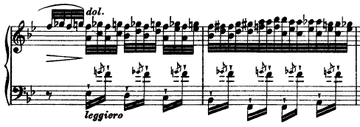Transcendental Études

The Transcendental Études (French: ''Études d'exécution transcendante''), S.139, are a series of twelve compositions for solo piano by Franz Liszt. They were published in 1852 as a revision of a more technically difficult 1837 series, which in turn were the elaboration of a set of studies written in 1826.
History
The composition of the Transcendental Études S.139 began in 1826, when 15-year-old Liszt wrote a set of youthful and far less technically demanding exercises called the Étude en douze exercices (Study in twelve exercises) S.136. Liszt then elaborated on these pieces considerably, and the far more technically difficult exercises called the Douze Grandes Études (Twelve Grand Studies) S.137 were then published in 1837.
The Transcendental Études S.139 are revisions of his Douze Grandes Études. This third and final version was published in 1852 and dedicated to Carl Czerny, Liszt's piano teacher, and himself a prolific composer of études. The set included simplifications, for the most part: in addition to many other reductions, Liszt removed all stretches of greater than a tenth, making the pieces more suitable for pianists with smaller hands. However, the fourth étude of the final set, Mazeppa, is actually more demanding than its 1837 version, since it very frequently alters and crosses the hand to create a "galloping" effect.
When revising the 1837 set of études, Liszt added programmatic titles in French and German to all but the Études Nos. 2 and 10. Editor Ferruccio Busoni later gave the names Fusées (Rockets) to the Étude No. 2, and Appassionata to the Étude No. 10; however, Busoni's titles are not commonly used. For example, music publisher G. Henle Verlag refers to these two by their tempo indications, molto vivace and allegro agitato molto, respectively.[1]
Henle ranks No. 4 (Mazeppa), No. 5 (Feux follets), No. 8 (Wilde Jagd), No. 10 (Appassionata) and No. 12 (Chasse-neige) as the most difficult études of the set at difficulty 9 out of 9. The lowest difficulty is given to No. 3 (Paysage) at 6 out of 9.[1]
Liszt's original idea was to write 24 études, one in each of the 24 major and minor keys. He completed only half of this project, using the neutral and flat key signatures. In 1897–1905 the Russian composer Sergei Lyapunov wrote his own set of Douze études d'exécution transcendante, Op. 11, choosing only those keys that Liszt had omitted, namely the sharp keys, to "complete" the full set of 24.[2] Lyapunov's set of études was dedicated to the memory of Liszt, and the final étude was titled Élégie en mémoire de Franz Liszt.
Other works with a similar title
- Sergei Lyapunov, 12 Études d'exécution transcendante, Op. 11 (1897–1905)
- Kaikhosru Shapurji Sorabji, Études transcendantes (100) (1940–44)
- Brian Ferneyhough, Etudes Transcendantales (1982–85)
Selected recordings
- Georges Cziffra, 1957-1958, EMI
- Lazar Berman, 1963, Victor
- Claudio Arrau, 1974-1976, Philips
- Michael Ponti, 1982, Leo Records
- Jorge Bolet, 1985, Decca
- Vladimir Ovchinnikov, 1988, EMI
- Janice Weber, 1988, MCA
- Leslie Howard, 1989, Hyperion
- Jenő Jandó, 1994, Naxos
- Boris Berezovsky, 1995-1996, Teldec
- François-René Duchâble, 1998, EMI
- Janina Fialkowska, 2000, Opening Day Recordings
- Freddy Kempf, 2001, BIS
- Christopher Taylor, 2002, Liszt Digital
- Bertrand Chamayou, 2005, Sony
- Alice Sara Ott, 2009, Deutsche Grammophon
- Vesselin Stanev, 2010, RCA Red Seal
- Mariangela Vacatello, 2010, Brilliant Classics
- Mélodie Zhao, 2011, Claves Records
- Vadym Kholodenko, 2013, Harmonia Mundi
- Daniil Trifonov, 2016, Deutsche Grammophon
References
External links
- Étude en 12 exercices, S.136, Grandes études, S.137, Études d'exécution transcendante, S.139: Scores at the International Music Score Library Project (IMSLP)
- Discography of Liszt's Transcendental Studies